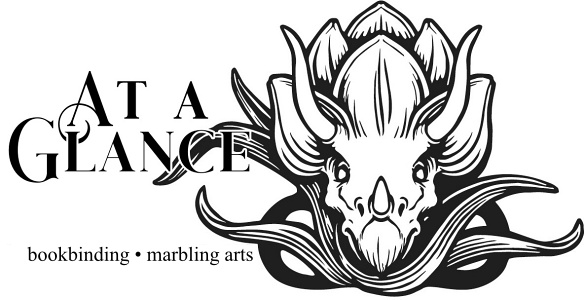If you’ve been making endbands on your books, you already know how much the right colors and pattern can add to a project. While rarely the focus of a fine binding, a well-done endband is like the matting on a painting. A good one will set it off perfectly and harmoniously.
This post is inspired by Kaija’s post of 7 tips for more professional looking handmade books: Paperiaarre.com. Reading these really leveled up my craft.
Here are some things I’ve learned that help to make beautiful endbands:
- When using multiple colors of thread, use all of the same type and brand. Different brands will have minute variations that the naked eye won’t notice, such as sheen levels or type of twists. By removing these small differences, your endbands will look more finished.
-you can use different types of threads to your advantage. If you are working on something that you want to have a very woodsy, earthy feel, using threads with slight differences can add to the organic nature. - Use threads that have the same ply. 1 and 2 ply threads will reflect light more if you want a shinier endband.
- Pay attention to how you twist the thread when you are wrapping around the core. If you’ve ever braided hair, you may have noticed that if you are twisting the individual hanks in addition to braiding, it creates more tension that will then “spring back” when you tie the braid off. Think of manipulating the thread in the same way, and don’t twist the thread more than you need to.
-In this same vein, if you are doing an endbands that has multiple threads on one strand (like chevron styles), maintain the position of the two threads continuously. When you are looking down at the top of the pattern, the two colors shouldn’t wrap around itself, but be side by side. - I learned this from watching Louis Bescond’s instagram reels: use a hard, smooth core instead of something that may change size while you are working the endband. Heat and moisture from your hands can make a paper core soften more and more as you are working, so the latter parts of your endbands won’t match the crispness of the start.
- WASHI TAPE!!!! Washi tape is the best for securing cores when you are first starting. I hold the cores in place with a bunch of washi tape so the beginning is so much more stable. And it’s great for holding down trimmed thread edges. Seriously, washi tape (or blue painters tape, any low-tack artist tape, really) is your friend.
- If you can’t find the right color in the right weight of thread, color your thread using sakura gellyroll pens. This is also helpful if you mess up your pattern.
- When you are finished with your endband, glue a strip of japanese tissue paper to the back over the threads. Use the curve of your finger to hold it in place, and straighten your threads and core with the tip of a bone folder. This helps to set the endband in place.

